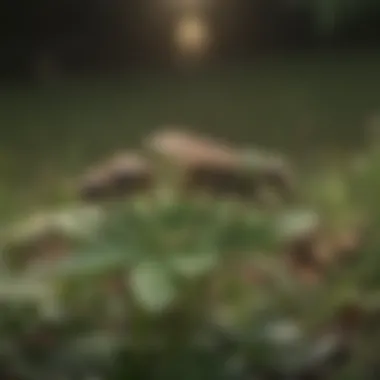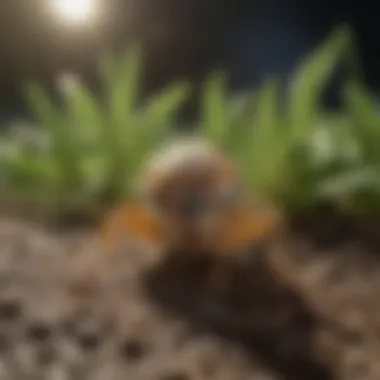Effective Clover Pest Control Strategies and Insights


Intro
Understanding clover pests is essential for maintaining a healthy garden. Clover serves as both a beneficial plant and a potential host for a variety of pests. Through effective management and control strategies, homeowners can minimize damage while fostering a balanced ecosystem. This article aims to equip readers with the knowledge required to confront clover infestations efficiently.
Understanding Pests
Definition of Pests
Pests are organisms that cause harm to plants and disrupt their growth. In the case of clover, these pests may include aphids, weevils, and spider mites. Each pest has distinct characteristics and behaviors that can affect the clover's health and surrounding plants.
Importance of Pest Identification
Identifying the pest is the first step in developing a pest management strategy. This allows for targeted approaches to control their populations. Observing your plant's condition and behavior helps detect early signs of infestation. Prompt identification leads to more effective solutions, reducing the potential for extensive damage.
Prevention Techniques
Home and Garden Preventative Measures
Prevention is key in pests management. Here are some measures that can be implemented:
- Regular Monitoring: Check clover patches weekly for any signs of pests.
- Proper Watering: Overwatering can attract pests. Ensure adequate drainage around clover plants.
- Crop Rotation: Change planting areas to disrupt pest life cycles.
Seasonal Prevention Tips
Changing seasons bring different challenges. Here are some seasonal tips:
- Spring: Prepare the garden by removing debris that may harbor pests.
- Summer: Use garden netting to prevent insect access.
- Fall: Clean up fallen leaves and plant debris to reduce hiding spots for overwintering pests.
Eco-Friendly Pest Control Solutions
Overview of Sustainable Practices
Sustainable practices focus on minimizing environmental impact while controlling pests. Utilizing integrated pest management (IPM) is crucial. This involves:
- Combining biological, mechanical, and chemical methods for pest control.
- Encouraging beneficial insects that naturally manage pest populations.
Natural Remedies and Their Effectiveness
Considerable research supports the use of natural remedies. Some effective options include:
- Neem Oil: Acts as a pesticide against various pests.
- Diatomaceous Earth: Helps control crawling pests by damaging their exoskeletons.
- Garlic Spray: Can deter pests due to its strong odor.
"Adopting eco-friendly solutions not only reduces damage to the environment but also fosters a healthier garden ecosystem."
Understanding the relationship between clover and its associated pests allows for effective control. By integrating prevention techniques and eco-friendly solutions, homeowners can protect their gardens and promote sustainable practices. This framework serves as a guide to creating a thriving environment without disrupting nature.
Understanding Clover Pests
Clover pests affect agricultural and gardening landscapes significantly. Understanding these pests is essential for keeping clover healthy and ensuring a thriving ecosystem. Clover serves multiple roles in the environment, including improving soil quality and providing forage for livestock. However, it can also attract various pests that threaten its growth.
Identifying these pests is crucial for effective management. It helps in recognizing their potential impact on clover health and ensuring proper interventions. This section focuses on how to identify common pests and understand their lifecycle and behavior.
Identification of Common Clover Pests
Clovers and their habitats
Clover species thrive in diverse habitats, ranging from lawns to wild meadows. These plants prefer well-drained soils and benefit from full sunlight. The adaptability of clovers to various environments makes them common in both urban and rural settings. Their ability to fix nitrogen in the soil enhances their appeal for land improvement. However, their habitats can also attract pests, which can lead to infestations.
The key characteristic of clover habitats is their lush, green foliage, which provides an attractive feeding ground for pests. In this article, we explore how maintaining a healthy clover habitat can minimize pest issues. One unique feature is the plant's resilience; clovers can regrow after pest damage, but persistent infestations can weaken them over time.
Major pests affecting clover species
Several pests specifically target clover. Aphids are among the most common, as are root weevils and clover leaf hoppers. Their presence can lead to significant damage, disrupting nutrient absorption in the plants. Recognizing these pests early is vital to managing infestations effectively.


The key characteristic that these pests share is their ability to reproduce quickly. For instance, aphids can multiply in a matter of days, leading to severe outbreaks. Understanding these pests is crucial for homeowners and gardeners who want to protect their clover. Each pest has unique effects on clover, from reducing growth to impacting overall health.
Lifecycle and Behavior of Clover Pests
Life stages of clover pests
Clover pests typically undergo several life stages, including egg, larva, pupa, and adult. Each stage has distinct characteristics and impacts on the clover plants. For instance, in the case of aphids, eggs are laid in the fall, and when spring arrives, they hatch into green nymphs that start to feed on clover leaves.
Understanding these life stages is beneficial for implementing targeted pest control measures. Knowing when the pests are most vulnerable allows for better timing of treatments against them. For example, interventions may be more effective during the nymph stage.
Feeding habits
The feeding habits of clover pests vary significantly. Aphids suck sap from clover, weakening the plant and making it susceptible to disease. In contrast, clover leaf hoppers feed on the surface, causing discoloration.
These feeding behaviors contribute to the overall problem of pest management. Recognizing feeding patterns can help in developing management strategies that are both effective and environmentally sound. For example, knowledge of when pests feed heavily informs the best times for applying insecticidal treatments, thereby protecting clover health.
Understanding the life stages and feeding habits of clover pests enables more effective management strategies, preserving the vibrant growth of clover while minimizing pest-driven damage.
Ecological Roles of Clover Pests
Understanding the ecological roles of clover pests allows us to appreciate their place in the ecosystem. While typically seen as nuisances, these pests contribute to various ecological dynamics that might not be immediately visible. Clover pests engage not only with the clover plants they infest but also with surrounding species, helping to maintain a balance in the ecosystem. Their roles have implications on clover growth and the broader environment, emphasizing the need to recognize their significance.
Impact on Clover Growth
Effects on nutrient absorption
Clover plants are crucial for soil health due to their ability to fix nitrogen. However, pests can hinder this process by damaging plant tissues. When pests feed on clover leaves, it limits the plant's capacity to absorb nutrients from the soil. This leads to weakened clover, which can struggle to thrive.
A prominent characteristic of this impact is reduced growth vigor, which can be especially detrimental in environments that rely on clover for soil enrichment. When nutrient absorption is compromised, the productivity of the clover is affected. This can lead to higher soil erosion and diminished biodiversity. Notably, this aspect of pest impact is often underappreciated by many homeowners, who may not connect pest presence with declining soil health.
Contribution to soil health
Clover pests indirectly shape soil health through their feeding behaviors. Certain pests can help break down organic matter as they digest clover, releasing nutrients back into the soil. This can be seen as a unique benefit of pest activities, despite their harmful reputation.
The key characteristic here is that pests can contribute to decomposition, aiding in nutrient cycling. Their presence can enhance soil texture, promoting aeration and water retention. However, the downside is that if pest populations escalate unchecked, their destructive habits might overshadow these benefits, leading to overall detrimental effects on the clover and surrounding flora.
Interactions with Other Insects
Predatory and parasitic relationships
Clover pests are not isolated in their environments; they participate in complex food webs. Many predators, such as ladybugs, thrive on clover pests, making these pests a vital food source in the ecosystem.
This interaction is significant as it supports biodiversity. Predatory insects help keep pest populations in check, making their presence beneficial in a balanced ecosystem. However, management becomes more complex if pest populations shift, resulting in an imbalance of these interactions, ultimately harming the clover's health.
Influence on pollination
Clover plants are important for local pollinators, offering nectar and pollen. Some pests affect the health of clover, which in turn impacts its ability to attract pollinators. Poor plant health can lead to lower flowering rates, thereby reducing resources for the bees and other insects that rely on clover for sustenance.
Understanding how clover pests influence pollination can aid homeowners in making informed decisions about pest management. Limiting pest populations can help sustain healthy clover and, in return, support local pollinators, ultimately benefiting the broader ecosystem.
Preventative Measures for Clover Pest Control
Preventative measures stand as critical components in managing clover pests. By proactively addressing potential infestations, gardeners can maintain healthier clover plants and reduce the reliance on more invasive control methods. Utilizing these approaches not only enhances the resilience of clover but also contributes to a more sustainable gardening ecosystem.
Cultural Control Techniques
Proper lawn maintenance
Proper lawn maintenance involves consistent and careful care of the clover grown in your lawn or garden. This means regular mowing, watering, and ensuring the soil remains aerated. The key characteristic of this practice is that it creates a less favorable environment for pests. Regular lawn care, allied with proper nutrition for the clover, assists in promoting dense, vibrant growth, which can naturally deter pest infestations.
A distinct advantage of proper lawn maintenance is that it is relatively low-cost yet highly effective. Those who tend to their lawns often notice increased vitality in their plants. However, neglecting this process can quickly turn a healthy garden into a pest haven. Maintaining a well-kept lawn is crucial for pest management and healthy crops.
Choosing resistant clover varieties


Choosing resistant clover varieties is another essential aspect of pest control. This involves selecting clover types known for their natural defenses against common pests. A noteworthy feature of resistant varieties is their genetic makeup, which has been developed specifically to withstand certain pest pressures. This practice is beneficial as it minimizes the need for chemical intervention, leading to an eco-friendly approach to pest management.
Resistant varieties can outcompete pests naturally, making them a popular choice among gardeners aiming for sustainable practices. One drawback, however, is that such varieties may not always be readily available or might require specific growing conditions that not all gardeners can provide. Still, the advantages often outweigh the challenges.
Mechanical Control Options
Handpicking pests
Handpicking pests remains one of the simplest methods of pest control. This technique involves physically removing pests, such as aphids or beetles, from the clover plants. Handpicking is particularly effective when the pest population is low. The key characteristic of this method is its immediate impact on pest reduction without the need for chemicals.
This method benefits gardeners by allowing for targeted control without harming beneficial insects. However, it can be time-consuming and may not be practical for larger areas. While labor-intensive, it is highly regarded for its effectiveness and sustainability.
Use of barriers and traps
Use of barriers and traps offers another effective mechanical control option for pest management. Barriers can include row covers or nets that physically block pests from accessing clover plants. Traps can be effective for monitoring and capturing pests. The main feature of this approach is its ability to protect plants without the use of harmful chemicals.
Barriers and traps are especially useful for preventing early infestations. They come with the advantage of being non-toxic, making them safe for both plants and beneficial organisms. However, the setup can require an initial investment in materials and potentially ongoing maintenance.
Ecological Pest Management Practices
Encouraging beneficial insects
Encouraging beneficial insects is a pivotal ecological approach in clover pest management. Beneficial insects, such as ladybugs and lacewings, prey on harmful pests. The unique feature of this strategy is fostering a balanced ecosystem in the garden. By creating habitats and providing food sources, homeowners can attract these helpful species.
This strategy is popular since it enhances biodiversity in gardens. Nevertheless, it may take time for beneficial insect populations to establish and effectively control pests, which is a potential disadvantage for those seeking immediate results.
Companion planting strategies
Companion planting strategies involve growing compatible plants near clover to deter pests and enhance growth. This method can improve soil health and increase resistance against pests. The core characteristic of companion planting is the use of plant relationships to naturally repel pests.
Benefits of this approach include stronger plant growth and reduced reliance on chemical controls. Each plant can contribute to the overall health of the ecosystem, fostering a harmonious growth environment. However, the complexity in recognizing effective pairings requires some knowledge and experimentation which may be daunting for some gardeners.
"Understanding and implementing these preventative measures for clover pest control not only safeguards clover health but also strengthens the overall gardening ecosystem."
Chemical Control Solutions
Chemical control solutions play a crucial role in the management of clover pests. These methods often become necessary when other strategies, such as cultural or mechanical controls, cannot effectively reduce pest populations. Proper use of chemical agents can significantly minimize damage to clover fields and ensure healthy growth. Homeowners and pest management professionals frequently rely on these methods as part of a comprehensive pest management strategy.
Overview of Acaricides and Insecticides
Types of chemical agents
Acaricides and insecticides are the primary categories of chemical agents used to control pests affecting clover. Acaricides specifically target mites and ticks, while insecticides focus on a broader range of insects. The key characteristic that differentiates these agents is their mode of action. For instance, some insecticides disrupt the nervous systems of pests, while others affect their growth and reproduction.
These chemical agents are beneficial for swift intervention against pest outbreaks. One unique feature of certain acaricides and insecticides is their residual activity, which can remain effective for an extended period after application. Although their effectiveness is advantageous, reliance on chemical control also raises concerns about potential resistance development among pests.
Application methods
The application methods for chemical solutions vary and can influence their effectiveness. Common methods include spraying, granulation, and soil drenching. The key characteristic of these methods is their ability to deliver the chemical precisely where pests are present. Spraying is often favored for its quick application and thorough coverage of foliage.
However, each method has its unique features. For example, spraying can be more effective in controlling surface-dwelling pests, while soil drenches can target pests that reside in the root zone. One disadvantage of application methods is the risk of non-target exposure, which can affect beneficial insects and disrupt the ecosystem.
Safety and Environmental Considerations
Chemical control measures should always consider safety and environmental impact. Proper usage not only protects the user but also safeguards surrounding wildlife.
Understanding chemical labels
Understanding chemical labels is vital for ensuring safe application and effectiveness. Labels provide essential information, including active ingredients, application rates, and safety precautions. The key characteristic of labels is that they help users calculate the correct dosage required for specific pest species. Having a clear understanding of these labels is beneficial to prevent misuse and optimize results.
One unique feature of chemical labels is their role in regulatory compliance. They often reflect government regulations regarding application and safety practices. Failure to adhere to these guidelines can provoke legal consequences and health risks.
Mitigating environmental impact


Mitigating environmental impact is another critical consideration when employing chemical controls. Strategies include choosing environmentally friendly products that target specific pests while minimizing harm to non-target species. The key characteristic here is selecting products that have a reduced effect on the environment, which is beneficial in supporting sustainability initiatives.
Unique features of mitigating strategies may include buffer zones to protect water sources and using integrated pest management techniques to reduce chemical dependencies. While these strategies can be effective, they may require more planning and monitoring than straightforward chemical applications.
Integrating Pest Control Approaches
Integrating pest control approaches is critical in the realm of clover pest management. This section is about combining various strategies for a more effective pest control plan. By integrating methods, homeowners can create a resilient ecosystem that not only addresses pest issues but also promotes overall plant health. It ensures a balanced approach, reducing the risk of pest resistance and improving the long-term sustainability of the garden.
Developing a Comprehensive Management Plan
A comprehensive management plan forms the backbone of effective pest control. It encompasses a systematic strategy, touching on various aspects of clover cultivation and pest management. The goal is to maintain pest numbers below harmful levels while safeguarding the environment and maximizing clover health.
Assessing pest thresholds
Assessing pest thresholds refers to determining the levels of pest populations that necessitate control measures. This evaluation is crucial because it helps farmers or homeowners decide when action is warranted. By identifying economic injury levels, one can avoid unnecessary treatments, saving both time and financial resources. A key characteristic of this aspect is its emphasis on informed decision-making. The unique feature here is that it fosters proactive management rather than reactive responses. If done correctly, this method can significantly reduce pest damage without over-relying on chemical pesticides. However, setting thresholds can be complex, as climate and soil conditions can vary significantly.
Monitoring and evaluation techniques
Monitoring and evaluation techniques involve keeping track of pest populations and assessing the effectiveness of control measures. Regular monitoring allows for early detection of pest problems and a timely response. This is important because it helps maintain an accurate picture of pest dynamics and their impact on clover health. A key characteristic of these techniques lies in their systematic nature, which ensures consistent data gathering. The unique feature includes adaptability; monitoring can be adjusted based on results obtained from previous evaluations. While these techniques are generally considered beneficial, they may require dedicated time and resources, which some may find challenging to commit to.
Adaptive Management Strategies
Adaptive management strategies are essential in responding to the challenges of changing pest populations. They focus on flexibility in pest control methods, allowing homeowners to adapt their approaches based on what is currently effective. This adaptability is especially valuable in a varying ecosystem where pest dynamics can shift unexpectedly.
Responding to changing pest populations
Responding to changing pest populations is about adjusting pest management strategies based on ongoing observations. As pest species can evolve and adapt, this responsive mindset is vital. A significant benefit of this approach is the potential for increased effectiveness, as strategies are tailored to specific situations. The key characteristic here is responsiveness, an ability to pivot quickly when needed. The unique feature of this method is that it promotes long-term pest management instead of short-term fixes. Some drawbacks may include the requirement for continuous knowledge and monitoring efforts.
Adjusting methods based on effectiveness
Adjusting methods based on effectiveness pertains to the ongoing assessment and refinement of pest management techniques. This process ensures that the most effective strategies are utilized over time, based on empirical data about what works. The key characteristic is the focus on performance metrics that guide decision-making. Such adjustments can lead to more sustainable pest control, promoting healthier clover growth. A unique feature of this method is that it encourages innovation; as new methods or products become available, older tactics may be phased out when they are less effective. However, reliance on constant adjustments may demand higher skill levels and understanding of pest dynamics.
Future Directions in Clover Pest Management
The future of clover pest management is marked by innovation and a deeper understanding of ecological balance. Emphasizing sustainable practices is crucial in developing strategies that are effective yet gentle to the environment. By integrating new technologies and evolving research methodologies, pest management can become more precise and less reliant on traditional chemical applications.
Research Trends in Pest Control Technologies
Advancements in biological controls
Biological controls represent a growing field that focuses on using natural enemies to manage pest populations. This method includes introducing or encouraging predators, parasites, or pathogens that specifically target clover pests. The key characteristic of these controls is their sustainability; they rely on natural processes instead of synthetic chemicals. This is a beneficial choice as it minimizes environmental disruption while promoting a balanced ecosystem.
Advantages of biological controls include low toxicity and the potential for long-term pest management solutions. However, certain unique features such as the time required for establishment and effectiveness can present challenges. Therefore, understanding local ecosystems is essential for optimal application.
Precision agriculture techniques
Precision agriculture techniques leverage modern technology to enhance pest management strategies through data analysis and monitoring. This method allows farmers and gardeners to identify pest presence with greater accuracy and address them accordingly. The key characteristic is its reliance on data-driven decisions, making it a highly beneficial approach.
This method's unique feature is the use of tools like drones and sensors, which provide real-time data about crop health. While the advantages include improved effectiveness and reduced resource use, the disadvantages can be associated with initial investment costs and the need for technical proficiency. Nevertheless, precision agriculture emphasizes the goal of effective pest management with minimal ecological footprint.
Regulatory and Policy Considerations
Regulatory frameworks surrounding pest management practices are increasingly focused on the environmental impact and sustainability. These regulations not only guide public safety standards but also encourage eco-friendly practices.
Environmental regulations
Environmental regulations play a vital role in determining safe practices for pest control. They aim to safeguard natural resources while promoting responsible usage of chemicals when necessary. The key characteristic of these regulations is their proactive approach, setting standards that protect ecosystems.
These policies are a beneficial aspect of pest management because they enforce accountability within the industry. However, unique features such as regional variations in laws can present challenges for implementation. Adhering to or understanding these regulations is essential for success in pest management.
Sustainable pest management policies
Sustainable pest management policies are gaining traction as more homeowners and professionals seek eco-friendly solutions. These policies advocate for methods that minimize chemical use while promoting biodiversity. The key characteristic is their comprehensive view; they include pest prevention strategies, monitoring, and control options.
This approach is beneficial because it addresses the need for ecological balance. Its unique feature is the long-term perspective on pest control that challenges traditional models focused purely on eradication. However, the implementation may be perceived as less immediate in effectiveness compared to conventional methods. Understanding how to align these policies with practical applications is crucial for homeowners and professionals alike.
The shift towards sustainable practices in pest management reflects a growing awareness of environmental responsibilities and the benefits of maintaining biodiversity.
As the landscape of pest management continues to evolve, both technological innovations and sound policies will shape future strategies. Homeowners and industry participants must stay informed about these trends to foster healthier ecosystems while effectively managing clover pests.



